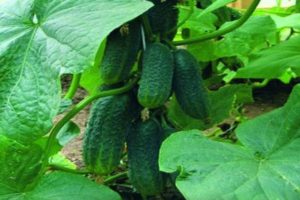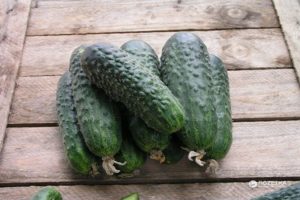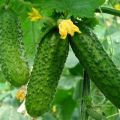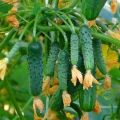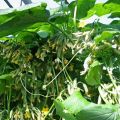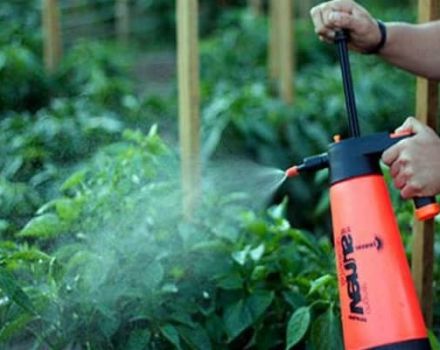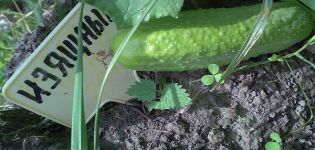Growing and shaping parthenocarpic cucumbers, the best varieties
The selection of cucumbers does not stand still, trying to facilitate the production of fruits in an easy way, without pollination. Parthenocarpic cucumbers are suitable for those summer residents who do not have the opportunity to transfer pollen from the stamen of one flower to the pistil of another, or to attract insects to this. Hybrids developed by breeders do not require pollination. But it is possible to get seeds from them in order to grow your favorite variety.
Pros of parthenocarpic varieties
Not everyone knows what this means parthenocarpic cucumber, often confusing it with self-pollinated. But modern hybrids don't need pollination, which means they don't have seeds inside.
The advantages of parthenocarpic hybrids include:
- abundance of flower formation;
- duration of fruiting;
- excellent taste;
- lack of bitterness in fruits;
- safety of presentation during transportation;
- preservation of useful properties for a long time.
Externally, the parthenocarpic cucumber is distinguished by a lush growth of the bush. And for eating this type of vegetable is most suitable. There are no seeds in the pulp of the fruit, which allows you to enjoy the greens to the fullest.
If only greenhouse conditions were suitable for the first hybrids, now there are varieties of cucumbers for open ground.
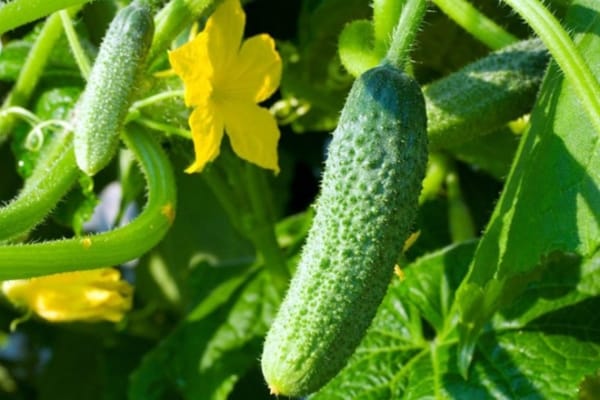
Partenocarpics for greenhouse
Of the cucumbers, parthenocarpic ones are especially suitable for greenhouses, because many of the hybrids do not tolerate sudden changes in air temperature.
Cucumber Furor F1 belongs to the early maturing type, because the variety bears fruit 37-39 days after germination. Of the characteristics of the hybrid, it can be distinguished from him:
- the power of the root system;
- uniformity of fruit color;
- abundance of the harvest;
- resistance to diseases - cladosporium, powdery mildew, mosaic.
The cucumber variety is suitable for pickling.
The April cucumber is suitable for greenhouses. In addition to excellent taste, it bears fruit for a long time, gives high yields.
Zozulya has a middle branch of the bush, from which tuberous fruits are collected. There are always a lot of them, they are of excellent presentation, do not turn yellow for a long time.
One of the varieties for pickling and pickling cucumber Kuzya F1. Although the greens are smaller than the usual ones, they taste crispy and juicy, without bitterness.
Parthenocarpic Emelya F1 is distinguished by early maturity. Cucumbers are fifteen centimeters long, dark green in color with large tubercles. The hybrid is ideal for greenhouses, where it pleases with high yields.

Description of cucumbers Advance gives an opportunity to get acquainted with a highly branched plant. It has excellent commercial qualities.
Cucumbers are harvested in July, they are good both fresh and for pickling.
The Arina hybrid is distinguished by a strong growth of the bush, which gives powerful lateral shoots. Vegetable of female type of flowering pleases with harvests of greens, long, glossy, with white thorns. In addition to salads, they are used for canning.
Parthenocarpic cucumbers bred for greenhouses are more suitable for fresh consumption, but some varieties are good for winter harvesting.
How to grow in a greenhouse
Before planting in the greenhouse soil, cucumber seeds undergo a series of procedures aimed at germination and hardening. Rejected and viable seeds are put in a bag and immersed in a container with water at room temperature. To accelerate the emergence of sprouts, a biostimulator of growth Zircon is added to the liquid. After a day of soaking, the planting material is transferred to a bag and placed on the lower shelf of the refrigerator. For purchased seeds, these procedures are not necessary, they are already prepared for planting.
Soil for greenhouses is prepared from humus with the addition of a complex of fertilizers, consisting of urea, potassium sulfate, superphosphate. In an unheated greenhouse, planting is carried out when the soil warms up to fifteen degrees Celsius. Cucumbers do not grow in low temperatures. They need a lot of warmth and light. Therefore, the scheme for planting cucumbers in a greenhouse is as follows:
- the distance between plants is not less than half a meter;
- rows one and a half meters apart;
- three seeds are placed in each well to a depth of two to three centimeters.
Germination takes place under a film after abundant watering.
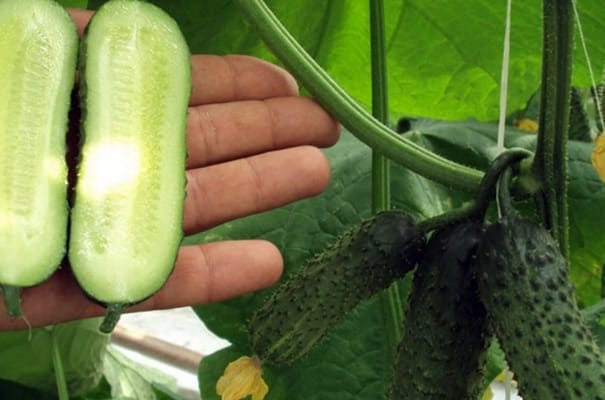
How to form parthenocarpic species
Caring for parthenocarpic cucumbers includes regular procedures:
- glaze;
- top dressing;
- loosening;
- weeding.
It is imperative that pinching is carried out in order to form a bush. This means that it is necessary to regulate the density and length of the cucumber branches. Without formation, the parthenocarpic hybrid of the cucumber will constantly shoot out. This means that all the strength of the root will go into the green mass, and not fruiting. Then there will not be enough light and food for the plants.
The formation of parthenocarpic cucumbers occurs when the fifth or sixth leaf appears on the plant. In the axils of these leaves, they remove all the flowers and shoots formed there, that is, they blind. Then pinch the rest of the lashes, leaving on the first in a small length of 20-25 centimeters, then higher - at 35-40 and 45-50. The main shoot is fixed on a trellis and pinched when it reaches its maximum length.
Growing parthenocarpic varieties in the open field
If at first parthenocarpic cucumber species grew only in a greenhouse, then gardeners got used to growing them in the open field.
Open ground varieties
Grows successfully in low temperature conditions, while retaining the ability to set fruits Bully cucumber. The hybrid bears fruit before frost, delighting with small, such as gherkins, fruits. Cucumber Trickle has similar characteristics.
The early-ripening Pyzhik gained popularity among gardeners for its disease resistance, excellent taste of zelents. From one square meter, the plant gives up to seventeen kilograms on the fortieth day after germination. Cucumbers Pyzhik are suitable for growing in greenhouse conditions and in the garden.

Dense and tender, without bitterness, cucumber flesh Uglich F1. With proper agricultural technology, in July they feast on small cucumbers of a rich green color with tubercles.
The Kanalya F1 hybrid is tied to a trellis, as the bush grows up to two to three meters in height. Appreciate the variety for early fruiting, use in salads, excellent presentation. The cucumber Zircon F1 also belongs to tall species. But it is better to grow it in seedlings.Suitable for cultivation in the fields. And his yield is excellent, and the cucumbers are even, retain their presentation for a long time, do not turn yellow.
All parthenocarpic cucumber varieties are resistant to diseases of the heat-loving vegetable. The fruits can be quickly realized, because they are tasty, tender, suitable for summer salads. Among them, there are many that are significant for fresh consumption in early summer. Variety Kucha Mala belongs to such parthenocarpics.
Among the fruitful hybrids, the cucumber Meva can be noted, which gives more than twenty kilograms of long greens with smooth skin from one square meter.
Reviews of gardeners about the varieties of the parthenocarpic species are only positive.
Growing rules in the garden
It is easy to care for hybrids outdoors. It is important for them to prepare a trellis about two meters high. The planting scheme is similar to that in the greenhouse soil. If the variety is highly branching, then the distance between the plants is fifty centimeters. When the entire bed is planted with hybrid plants, the stem is formed simultaneously, when flowers and shoots appear on the main shoot in the axils of the first five leaves. Blinding is carried out, such an action in which flowers and shoots are completely removed. The rest of the lashes, located above the fifth leaf, are only pinched.
Cucumbers are also watered depending on the growth periods. At first, moisturize moderately, reducing the frequency of watering and its abundance during the appearance of inflorescences. As soon as the vegetable fades, the frequency of watering is increased. Do not forget that the water must be taken warm.
Top dressing is performed using a mullein diluted in ten liters of water or mineral fertilizers. You can spray cucumber leaves with a nutrient solution. It is prepared by adding wood ash.

Many parthenocarpic cucumber species are grown because they have many positive qualities and do not require careful maintenance.
